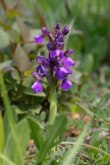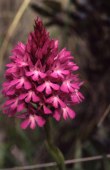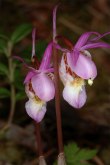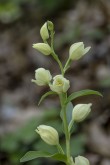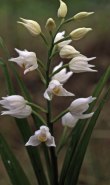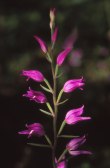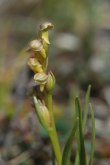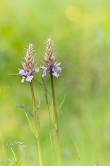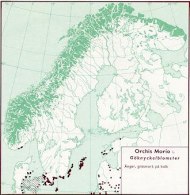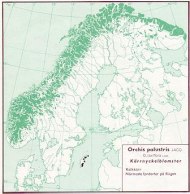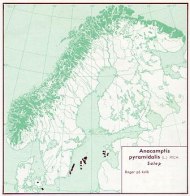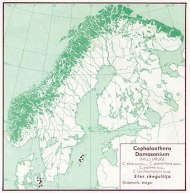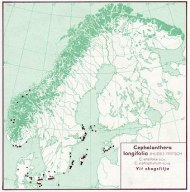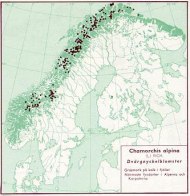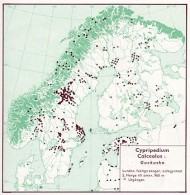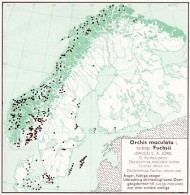Orchids in Sweden
Here below all Swedish orchids are presented. I have choose to do this presentation in a strictly alphabetical order using the Latin names, not according the order commonly used in floras where the scientific system for plants is used.
As for nomenclature, I have used Mossberg / Nilsson: Den nya nordiska floran (The new Nordic flora), regarding both the Swedish and Latin names.
Each species has a brief description and a picture showing what the species looks like. There is also a link to the image gallery for this species in case you want to see more pictures. In addition there are, with the permission of Naturhistoriska Riksmuseet's (the Natural History Museum's) website "The virtual flora", maps showing each species' distribution in Scandinavia. Clicking on the map will open a slightly larger image directly in the NRM's website. For those who want to know more about the actual species are advised to read further on "The virtual flora" (Swedish) for further information on the species.
Orchids can be found over almost the whole of Sweden. However, many are tied to specific environments and are then often very local and rare. Several of our orchids are here at the extreme northern limit of its distribution and grow here only in specific environments, although they further south in Europe are growing in different environments.
Orchids in Sweden are all perennial herbs. All, like all European orchids, are terrestrial. A few are saprophytes, which mean they live underground and only send up a flower stalk to set seeds.
There are some typical characteristics which are common to our orchids:
- They are all monocots.
- They have no loose pollen; the pollen is gathered in clumps that sit on a "shank," pollinia.
- All are pollinated by insects (to some extent self-pollination occurs ).
- The flowers always have six petals and have an unsymmetrical shape.
- The seed capsules burst up after markings on the sides that go from the base to the top and the seeds are then spread by the wind.
- The seeds are microscopic and often in thousands in each seed pod.
- Since the seed is lacking endosperm, it has to meet a fungus partner to be able to germinate.
1 Anacamptis morio (L) R.M.Bateman, Pridgeon & M.W.Chase
Green-winged Orchid is growing in Sweden in Skåne, Öland and Gotland. Following recent findings in orchid research, this species have been moved from Orchis to Anacamptis.
It is a robust plant with usually a dense spike. The flowers are usually purple, but can vary greatly. The sepals are green veined. The lip is broader than long and has from the thick spur onwards a white center with red spots. It is slightly three-lobed and side lobes are folded down. White color forms occur. A. morio has a very large distribution area, covering most of Europe and eastwards to Iran. To the south, the limit is unclear because confusion with A. picta which in some areas completely could replace it. The species has declined almost everywhere due to improvement in agriculture. Flowering: May-June.
2 Anacamptis palustris (Jacq.) R.M.Bateman, Pridgeon & M.W.Chase
Anacamptis palustris is in Sweden only known from Gotland. This is also the northern limit for this species. It is a slender plant, 20-40 cm, and the inflorescense is quit lax. Leaves are narrow and erect almost grass-like. The rather large flowers are pink to pale purple. The lip is weakly three-lobed, has a whitish center with purple dots and streaks. Rather long and thick spur; near horizontal. Habitat: Open calcareous bog and marsh-edges at a few sites at Gotland. Distribution is Europe, eastward to Anatolia (Turkey), but throughout its range, it has declined strongly due to drainage of wetlands. Locally, however, it may be common. Flowering: July.
3 Anacamptis pyramidalis L.C.M. Richard
Only sites in Sweden for Pyramidal Orchid are at its distribution area's northern outposts, Öland and Gotland. The species names in Latin, is received from the pyramidal shape of the inflorescence, especially before all flowers opened up, it is very conical. Later on it got a rounded shape. The flowers in the very dense inflorescence are small. The spur is long and thin, in the spur mouth there is a rib on each side which helps to control the nectar applicants butterfly proboscis right. The lip is three-fold, but the shape of the lobes can vary significantly between different locations. This is also valid for the color that can vary from dark lilac to pure white (alba-forms) and a number of names are given to this different variants/forms. Plant height 20-60 cm. Habitat: Usually poor grassland, old pasture and arable land, meadows and open forests. Distribution: Almost the whole Europe. Flowering: July.
4 Calypso bulbosa (L) Oakes
The Calypso orchid is, next Lady's Slipper, the the Swedish orchid that have the largest flower, still most people who see it for the first time says "... but isn´t bigger." This probably depends on the hight of the plant, it can reach about 20 cm but usually much shorter. This species belongs to the flora of the northern Sweden and Finland. It is missing In Norway
The name, Calypso, is from the Greek mythology, named after the beautiful nymph Calypso, daughter of Atlas. The species name, bulbosa, refers the root. The plant have a stem with a singel flower, at the base there is a oval, pleated leaf. The stem is at the lower part surrounded by some brown sheaths and has at the top a pink/red bract. The flower is pink except for the lip that usually is white or light pink. The base of the lip is cup shaped and streaked with purple inside. This extending forward to a two-lobed, yellow spur. Grows in damp mossy and not too dense coniferous forests. Flowering: June or July due to snow melt.
5 Cephalanthera damasonium (Miller) Druce
In Sweden the White Helleborine can only on be found at the island of Gotland, which is a northern outpost of this otherwise South and Central European species. The wide rather short leaves gradually shifting to bracts that are rather dominant in the lax inflorescence. The flowers (3-15) are yellowish white and opens poorly, they have a lily-like appearance which is also seen in the Swedish name (big forest lily). The epichile is yellow at its base. This species is regularly self-pollinated. Grows usually in mid-shade to shaded areas on dry, calcareous, coastal woodland. Distribution is most of Europe and part of Asia, but everywhere quite rare. Flowering: June — July.
6 Cephalanthera longifolia (L.) Fritsch
Swedish name of Sword-leaved Helleborine is "white forest lily" (Vit skogslilja). it differs from White Helleborine through the large number of flowers (8 — 30) and longer and narrower leaves. The bracts are also smaller. The flowers are pure white with a yellow tip on the epichile. The inflorescence has a larger and more stately appearance. Usually the flowers are whiter than those at White Helleborine. Habitat is open woodland and sometimes moist grasslands. Occasionally when Sword-leaved Helleborine is growing together with Red Helleborine hybrids between them can be found. Since Sword-leaved Helleborine can tolerate different environments it seems to be somewhat favored by today's farming conditions. In Sweden, outside Öland and Gotland, Sword-leaved Helleborine are mainly found along the east coast with only a few inland sites. Distribution is Europe and the temperated zone of Asia. Flowering: June.
7 Cephalanthera rubra (L.) L.C.M. Richard
Red helleborine is the third of the Swedish native helleborines. It is unlikely that any confusion with other species can be done, due to its unique, large, red flowers, although there are reports of white flowering specimens. C. rubra is a stately plant that can grow up to 65 cm and have 10 or so flowers. The rose-red flowers open usually much more than C. damasonium and longifolia. The pointed lip has a white field with yellow streaks. At overgrowth C. rubra can survive underground for years and return when conditions become favorable again. In Sweden the species can be found in some provinces north to Värmland. Best known area for this species is Gotska Sandön. Hybrids with C. longifolia are rare but can be found where the species meet. Distribution is Europe and the temperate part of Asia. Habitat is usually dry, open woodland, mainly at lime. Flowering: June-July.
8 Chamorchis alpina (L.) L.C.M. Richard
This is a monospecific genus, the only species being the Dwarf Alpine Orchid. The name, Chamorchis, comes from the Greek and refers to the low growth habit and so does the Swedish name dvärgyxne, because this is a dwarf in the context of orchids. Most often, the plants do not grow more than 5–6 cm in height. The small flowers, usually only two or three but can be up to 10, are green with a tinge of brown on the helmet formed by the petals. The lip is yellow/yellowish green with a hint of tripartite. The distribution in Sweden is the high mountains from the western part of Härjedalen and north to Lapland's northern mountain. It is otherwise found in the Norwegian mountains as well as the alpine areas of southern Europe where you hardly find it below 1,500 m. Growing places are calcareous, alpine areas, Dryas areas, rock terraces. Flowering: July–August.
9 Corallorhiza trifida Chátelain
Korallrot has become the Swedish name for this small orchid. It is the root that has given the name. It looks like a coral with all its short branches. Coral Root is a saprophyte and has no green leaves, it lives in symbiosis with a fungus that gives it the nutrition it needs. It is only visible above ground when it flowers and sets seed. The flower stalk is 10–25 cm long and is surrounded by brown leaf sheaths. The sparse spike at the top bears up to 10 small, yellow-green flowers. However, the white lip has some red streaks. The Coral Root is found in almost the entire country. It grows in moist, shady woodlands under bushes, in alpine wetlands it grows openly. The total distribution is the northern hemisphere's coniferous forest areas. Flowering: May–June.
10 Cypripedium calceolus L.
Lady's Slipper is probably familiar to most people. This is the one of our orchids with the largest flower and perhaps the only one that can compete with the tropical species that we usually grow at home. It got its Swedish name from an old dialectal name, "gucku", which means cuckoo, and probably the connection was made because it blooms during the time when you hear the cuckoo. The Latin species name, calseolus, means "little shoe" and refers to the lip. Lady's Slipper belongs to a group of orchids that are considered more primitive than most others. It has e.g. no pollinia but the pollen is present as clumps that the insects access. The large yellow pouch is the lip which has been turned into a trap for the insects which can only get out via openings at the base of the lip. There they pass the pollen that sticks to the body and thus bring pollen to the next flower. Sepals and petals are brown. The petals are long and narrow and usually twisted like spirals. They are stately plants that can reach a height of up to 70 cm. Each flower stalk bears 1–3 flowers. Lady's Slipper often grows in dense groups, which makes the overall impression even more pompous. In Sweden, Lady's Slipper is mainly found from Väster-/Östergötland and northwards, always in limestone areas. Flowering: Late May–July.
11 Dactylorhiza fuchsii subsp. fuchsii (Deuce) Soó
The Common Spotted Orchid normally reaches a height of 30–60 cm. Leaves oblong, mottled, lowermost leaf with rounded tip. Red-violet flowers with darker markings on the deeply three-lobed lip, the middle lobe as large as the side lobes, which is the character by which it is most easily distinguished from D. maculata. Conical inflorescence. Grows in open forest and forest edges, but you can also find it on sunny areas such as pastures and meadows. It is linked to limestone areas. The species hybridizes extensively with other species within the genus. Hybrids with D. incarnata produce large plants that sometimes grow in large groups and are an impressive sight. Available pretty much throughout the country. The total distribution is unclear due to confusion with other related species but with a probable concentration within western and central Europe. Flowering: June–July.
To be continued

